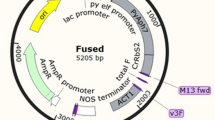Abstract
The effect of light intensity, pH and carbonic anhydrase (CA) inhibitors on photosynthesis of the red marine macroalgae Solieria filiformis (Kützing) Gabrielson, collected from Taliarte (Gran Canaria, Canary Islands) in 1991, has been investigated. Plants taken from the sea (“wild phenotype”) developed spherical morphology (“ball phenotype”) after 2 mo culture in aerated tanks. The photosynthetic oxygen evolution in the wild phenotype was saturated at 100 μmol photons m-2s-1, while the “ball” phenotype displayed saturation at 200 μmol photons m-2s-1. The inhibitors of total CA activity (6-ethoxizolamide) and extracellular CA activity (dextran-bound sulfonamide) inhibited photosynthesis at pH 8.2, to 90 and 50% respectively, in both phenotypes. No inhibition of the photosynthetic oxygen evolution was detected at pH 6.5. CA activity was associated with both supernatant and pellet fractions of crude extracts of S. filiformis. The rate of alkalization of the medium by the algae was dependent on light intensity. We suggest that carbon dioxide is the general form of inorganic carbon transported across the plasmamembrane in S. filiformis. HCO3 transport into the cell takes place simultaneously by an “indirect” mechanism (dehydration to CO2 catalyzed by CAext) and by direct uptake. Extracellular (CAext) and intracellular (CAint) CAs are involved in the mechanisms of inorganic carbon assimilation by S. filiformis.
Similar content being viewed by others
Literature cited
Axelsson, L. (1988). Changes in pH as a measure of photosynthesis by marine macroalgae. Mar. Biol. 97: 287–294
Beer, S., Eshel, A. (1985). Determining phycoerythrin and phycocyanin concentrations in aqueous crude extracts of red algae. Aust. J. mar. Freshwat. Res. 36: 785–792
Beer, S., Israel, A. (1990). Photsynthesis of Ulva fasciata. IV. pH, carbonic anhydrase and inorganic carbon conversions in the unstirred layer. Pl., Cell Envir. 13: 555–560
Bidwell, R. G. S., McLachlan, J. (1985). Carbon nutrition of seaweeds: photosynthesis, photorespiration and respiration. J. exp. mar. Biol. Ecol. 86: 15–46
Björk, M., Haglund, K., Ramazanov, Z., García-Reina, G. Pedersén, M. (1992). Inorganic carbon assimilation in the green seaweed Ulva rigida C. Ag. (Chlorophyta). Planta 187: 152–156
Cook, C. M., Lanaras, T., Colman, B. (1986). Evidence for bicarbonate transport in species of red and brown macrophytic marine algae. J. exp. Bot. 37: 977–984
Cook, C. M., Lanaras, T., Roubelakis-Angelakis, K. A. (1988). Bicarbonate transport and alkalization of the medium by four species of Rhodophyta. J. exp. Bot. 39: 1185–1198
Falkowski, P. G., LaRoche, J. (1991). Acclimation to spectral irradiance in algae. J. Phycol. 27: 8–14
Goyal, A., Tolbert, N. E. (1989). Uptake of inorganic carbon by isolated chloroplasts from air-adapted Dunaliella. Pl. Physiol. 89: 1264–1269
Haglund, K., Björk, M., Ramazanov, Z., García-Reina, G., Pedersén, M. (1992). Role of carbonic anhydrase in photosynthesis and inorganic carbon assimilation in the red alga Gracilaria tenuistipitata. Planta 187:275–281
Lucas, W. J. (1983). Photosynthetic assimilation of exogenous HCO −3 by aquatic plants. A. Rev. Pl. Physiol. 34: 71–104
Mareus, Y., Volokita, M., Kaplan, A.. (1984). The location of the transporting system for inorganic carbon and the nature of the form translocated in Chlamydomonas reinhardtii. J. exp. Bot. 35: 1136–1144
Morgan, K. C., Shacklock, P. F., Simpson, F. J. (1980). Some aspects of the culture of Palamaria plamata in greenhouse tanks. Botanica mar. 23: 765–770
Moroney, J. V., Husic, D. H., Tolbert, N. E. (1985). Effect of carbonic anhydrase inhibitors on inorganic carbon accumulation by Chlamydomonas reinhardtii. Pl. Physiol. 77: 177–183
Palmqvist, K., Ramazanov, Z., Samuelsson, G. (1990). The role of extracellular carbonic anhydrase for accumulation of inorganic carbon in the green alga Chlamydomonas reinhardtii. A comparison between wild-type and cell-walless mutant cells.Physiologia Pl. 80: 267–276
Peterson, G. L. (1983). Determination of total protein. Meth. Enzym. 91: 95–119
Provasoli, L. (1968). Media and prospects for the cultivation of marine algae. In: Watanabe, A., Hattori, A. (eds.) Cultures and collections of algae. Japanese Society of Plant Physiologists, Tokyo, p. 63–75 Proc. U.S.-Japan Conf. Hakone)
Ramazanov, Z. M., Semenenko, V. E. (1988). Content of the CO2-dependent form of carbonic anhydrase as a function of light intensity and photosynthesis. Soviet Pl. Physiol. 35: 340–344
Raven, J. A., Lucas, W. J. (1985). The energetics of carbon acquisition. In: Lucas, W. J., Berry, J. A. (eds.) Inorganic carbon uptake by aquatic photosynthetic organisms. American Society of Plant Physiologists. Rockwell, Maryland, p. 305–324
Sand-Jensen, K., Gordon, D. M. (1984). Differential ability of marine and freshwater macrophytes to utilize HCO −3 and CO2. Mar. Biol. 80: 247–253
Simpson, F. J., Neish, A. C., Shacklock, P. F., Robson, D. R. (1978). The cultivation of Chondrus crispus. Effect of pH on growth and production of carrageenin. Botanica mar. 21: 229–235
Smith, R. G., Bidwell, R. G. S. (1987). Carbonic anhydrase-dependent inorganic carbon uptake by the red macroalga Chondrus crispus. Pl. Physiol. 83: 735–738
Smith, R. G., Bidwell, R. G. S. (1989). Mechanism of photosynthetic carbon dioxide uptake by the red macroalga, Chondrus crispus. Pl. Physiol. 89: 93–99
Sültemeyer, D. F., Miller, A. G., Espie, G. S., Fock, H. Canvin, D. T. (1989). Active CO2 transport by the green algae Chlamydomonas reinhardtii. Pl. Physiol. 89: 1213–1219
Wintermans, J. F. G., De Mots, A. (1965). Spectrophotometric characteristics of chlorophylls a and b and their pheophytins in ethanol Biochim. biophys. Acta 109: 448–453
Author information
Authors and Affiliations
Additional information
Communicated by J. M. Pérès, Marseille
Rights and permissions
About this article
Cite this article
Gómez-Pinchetti, J.L., Ramazanov, Z. & García-Reina, G. Effect of inhibitors of carbonic anhydrase activity on photosynthesis in the red alga Soliera filiformis (Gigartinales: Rhodophyta). Marine Biology 114, 335–339 (1992). https://doi.org/10.1007/BF00349536
Accepted:
Issue Date:
DOI: https://doi.org/10.1007/BF00349536




